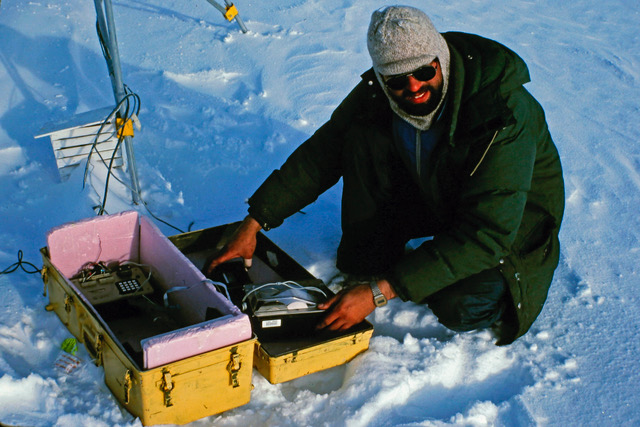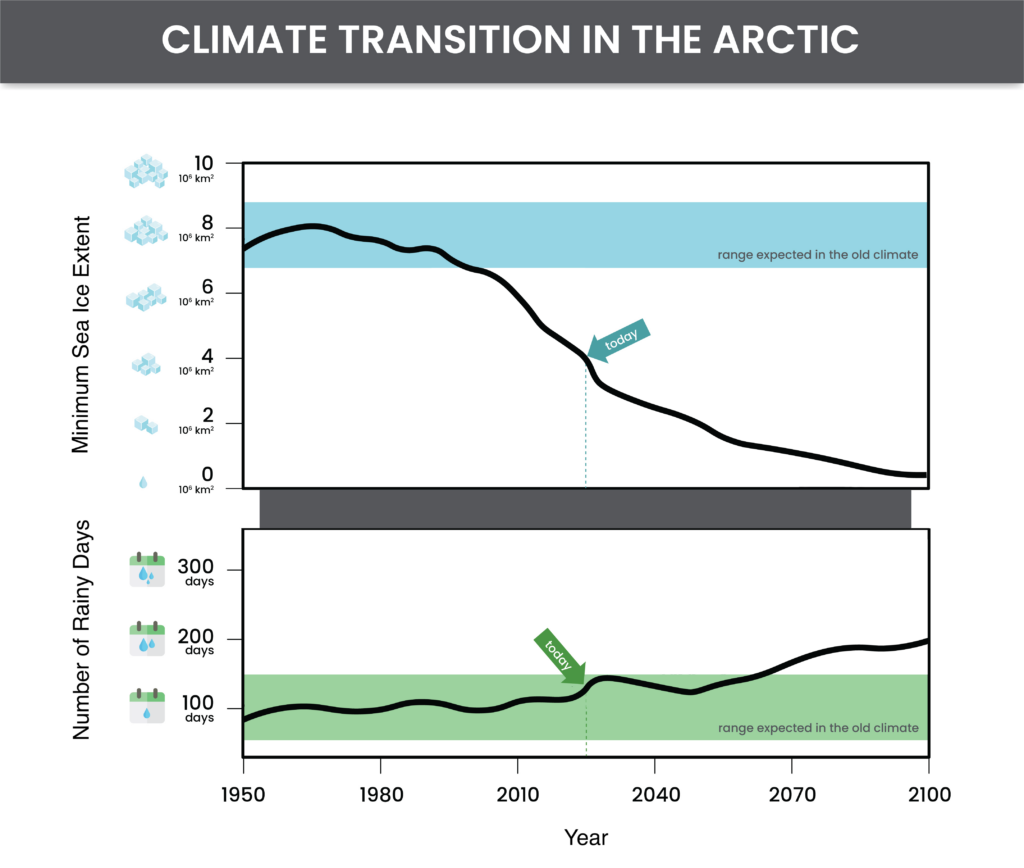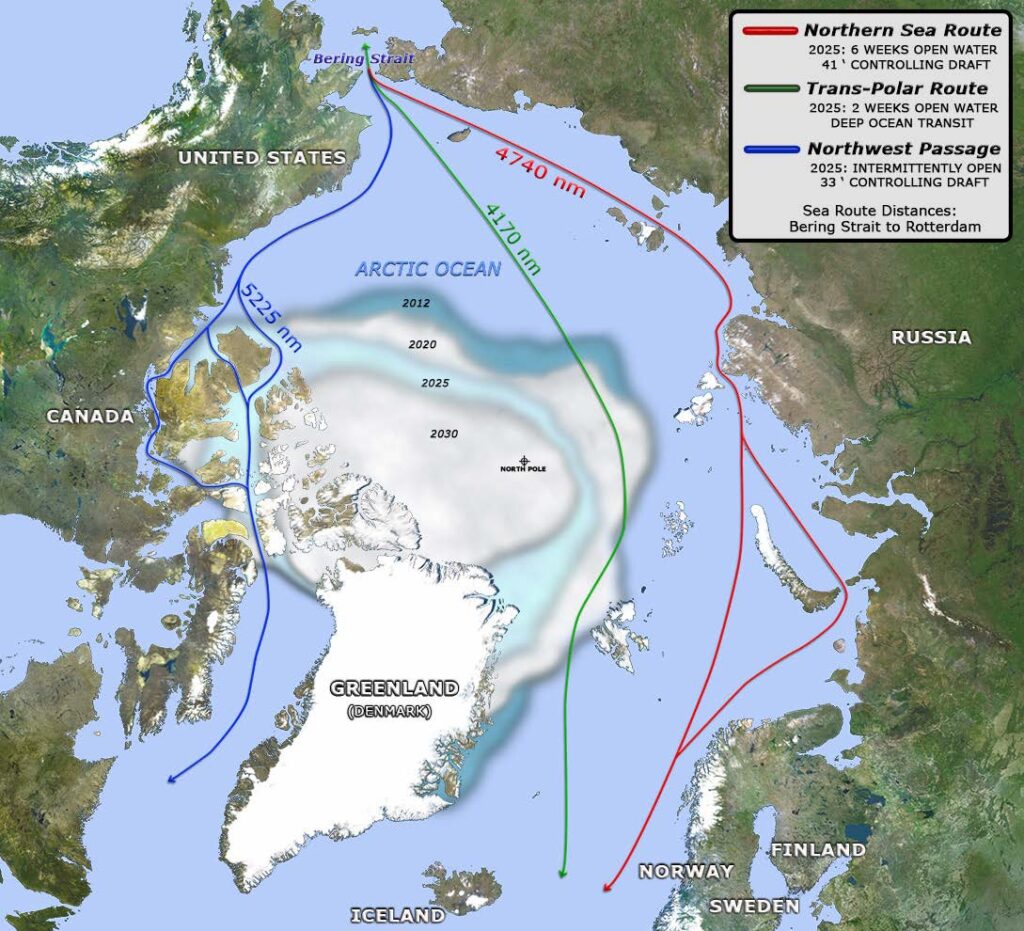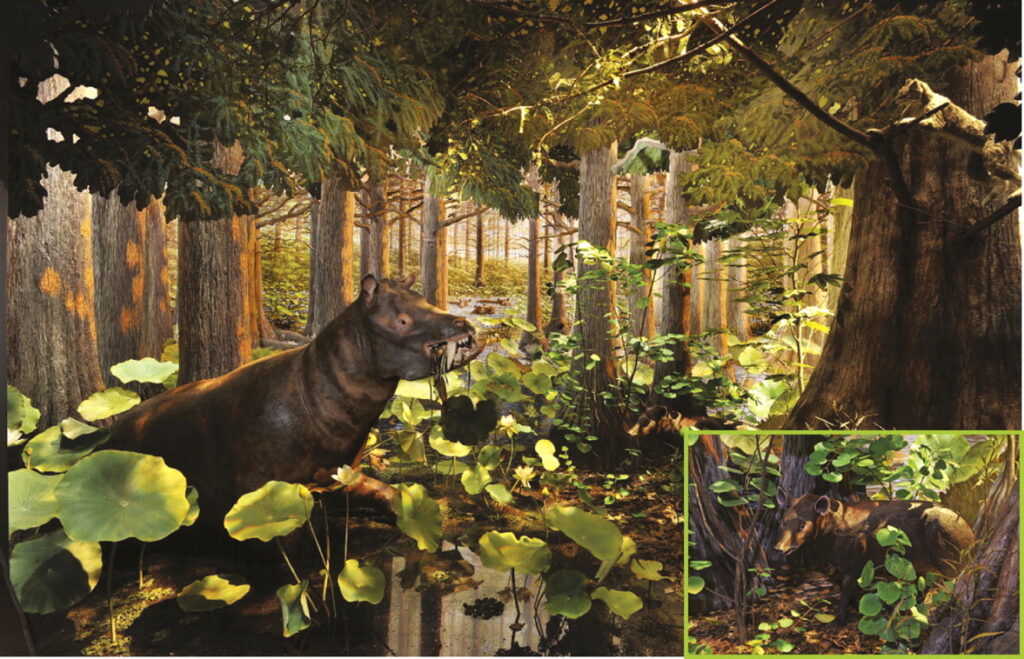As a doctoral student at the University of Colorado Boulder in the 1980s, Mark Serreze studied sea ice in the Beaufort Gyre, a current in the Arctic Ocean just north of Canada. He used a network of drifting buoys to track the movement of the ice pack, finding that floes of sea ice periodically opened in response to summer winds. He also studied the terrestrial St. Patrick Bay ice caps of Ellesmere Island in Nunavut, Canada.
Serreze now directs the National Snow and Ice Data Center at the University of Colorado Boulder, where he continues to study ice in a warming world. But the St. Patrick Bay ice caps he visited for his graduate work no longer exist—they’ve since melted away as climate change has advanced, mostly unabated.

Today, Serreze sees “an Arctic that is losing its character, losing its soul, that soul being its snow and ice.”
In the past few decades, sea ice—the engine of the Arctic climate—has diminished dramatically, with the total area of ice cover down about 50% from the 1980s. Precipitation patterns now bring more rain and less snow to the Arctic. Thawing long-frozen ground allows for more severe erosion. And vegetation is growing faster and farther north in response to rising air temperatures.


The Arctic is “drastically different from what it was,” said Jennifer Francis, a climate scientist at the Woodwell Climate Research Center in Massachusetts.
Scientists use past climate data and estimates of future greenhouse gas emissions to simulate how these changes may continue in the future. But system complexity, natural variability, and limited data mean these forecasts can vary.
“All models are wrong,” the saying goes, “but some are useful.”
Combining simulations that have varying assumptions, initial climate conditions, and data into ensembles reduces—but doesn’t eliminate—uncertainty. Ensembles agree that as long as we produce greenhouse gases (and even after we stop), the Arctic will continue to warm, creating a cascade of changes. The details of those predicted changes, however, range widely.
The Arctic over the next century could look like a slightly warmer version of today’s Arctic. Or it could be unrecognizably altered. The farther into the century we forecast, the more uncertain its future becomes.
Just how much the Arctic changes depends on the steps humanity takes to halt or even reverse climate change, said Laura Landrum, a climate scientist at the National Center for Atmospheric Research. “It’d be good if we’d started yesterday,” she said.
2040
Without major reductions in greenhouse gas emissions, the changes scientists currently see in the Arctic will greatly accelerate by 2040.
In just 15 years, permafrost thaw and increasing precipitation will mean some rivers in the Arctic will swell with water and erode their banks more quickly. The once-solid ground beneath some Arctic towns, especially those on the coast, may yield to the water.
Because of erosion and sea level rise, residents of places like Shishmaref, an Alaska Native community located on a highly vulnerable barrier island, may be forced to move. Indeed, officials in Shishmaref and in at least 12 other Native Alaskan villages are already exploring relocation plans.
Warmer ocean waters will also fuel ever more destructive storms. Events like Typhoon Merbok, which caused widespread flooding in coastal Alaska in 2022, will be more common.
The Arctic biosphere will also change. At least one species of algae, Alexandrium catenella, could take advantage of warmer oceans and spread northward from its habitats in temperate and subpolar waters, said Don Anderson, a biologist at the Woods Hole Oceanographic Institution in Massachusetts.
These bloom-forming algae produce toxic compounds that contribute to “red tides” elsewhere in the world. In the Arctic, the algae could poison marine life and contaminate food such as clams, which some coastal Arctic communities rely on. Widespread blooms could kill other Arctic life such as seabirds, walruses, and whales.
Our incomplete understanding of the life histories of harmful algae in cold environments, as well as of the influence of competing species and potential predators, means we can’t say for certain that warmer oceans will directly lead to more harmful algal blooms, however. “There will be winners and there will be losers” in the ecosystem, Anderson said.
By 2040, warming could thaw about 10%–40% of high-latitude permafrost, a process that emits greenhouse gases including methane and carbon dioxide (CO2) as long-frozen remains of animals and plants are exposed to air and begin to decay. Scientists can’t narrow down in on exactly how much permafrost will thaw, or how the thaw will affect Arctic systems, Serreze said. That’s because they aren’t sure how much carbon dioxide and methane are present in Arctic permafrost or when and where it could escape.
Today the Arctic is warming anywhere from 2 to 4 times faster than the rest of the world in a phenomenon known as Arctic amplification. Calculating the Arctic amplification ratio is simple, Serreze said: Just pick a time period or season, determine how temperatures in the Arctic and elsewhere have changed, and divide. That amplification ratio is expected to increase, but scientists aren’t sure by how much. That uncertainty can complicate climate projections, too.
Emergence
Some scientists think that a new Arctic climate will have emerged by 2040. No longer dominated by ice and snow, the Arctic will become something altogether different, warmer and wetter.
Landrum defined this emergence as a state when the Arctic climate no longer fits expected patterns based on the past 30 years of data, when “the idea of a climate normal doesn’t really work anymore,” she said.

This schematic illustrates emergence—the point at which current trends are so far outside the range of past climate data that they are no longer useful to project future climate.
In the top graph, minimum sea ice extent is far outside the range expected. This system has emerged. In the bottom graph, the number of rainy days is close to exceeding, but still within, the expected range. This system has not yet emerged. (Image credit: Modified from Simmi Sinha/UCAR)
The process of emergence diminishes scientists’ ability to use records of a system’s past to pinpoint specific changes to its future, such as the intensity of future heat waves or the number of future typhoons.
Instead, scientists modeling emerging systems rely more heavily on their understanding of the physics of those systems, for example, how heat transfer works between the ocean and the atmosphere.
If scientists had a complete understanding of Earth systems, emergence wouldn’t pose a problem. But they don’t, and they lack the resources and data to do so.
In a recent paper, Landrum and a colleague suggested that Arctic emergence has already begun. Minimum sea ice extents in the Arctic now lie well outside the ranges that modelers would expect when using data from the past 30 years. Landrum’s conversations with Arctic residents indicate to her that regional air temperatures and precipitation patterns could deviate from climate normals relatively soon, too, if they haven’t already.
Carbon dioxide stays in the atmosphere for hundreds of years. Even drastic cuts to emissions today won’t prevent changes in the Arctic by 2040, because much of that warming is “baked in” to the system.
Geoengineering approaches such as carbon capture and marine cloud brightening could slow the changes, but only if the science is settled enough to prove their efficacy and the political will exists to implement such solutions. And geoengineering shouldn’t be just an “excuse for continuing to consume and produce more fossil fuels,” Landrum said.
Many people and communities have committed themselves to meaningful adaptations in the Arctic, from coastal resilience planning to implementing near-real-time monitoring and advanced warning for algal blooms.
But it may not be enough. “What we need to do is guess at what might be some of the worst-case events…and then try and plan to avoid those,” said James Overland, an Arctic oceanographer for NOAA’s Pacific Marine Environmental Laboratory.
2060
Thirty-five years from now, consistent summer sea ice will likely be a memory, much like reliable snow in the northeastern United States or summers without record-breaking heat waves. Some summer sea ice may still cling to the edges of Arctic shores, or the occasional summer will still have Arctic-wide sea ice. But most climate scientists agree: By mid-century, many Arctic summers will be virtually free of sea ice.

“Barring really dramatic carbon reductions that are probably not realistic,” summer sea ice loss is probably inevitable, according to Walter Meier, a sea ice scientist at the National Snow and Ice Data Center.
And that loss will have widespread consequences for the Arctic, some of which we’re already beginning to see.
Without sea ice, Arctic processes could break down.
Without ice as a barrier, more heat transfer occurs between the ocean and the atmosphere. As more moisture enters the air, it causes more precipitation and stronger storms, which scientists are already noticing, Francis said. Without sea ice to temper wave action, storms could fuel more powerful seas and more destructive coastal erosion. Coastal areas may also face worsening flood risk, and even more communities may be forced to move.
The temperature gradient between the once-cold Arctic and warmer, more southern latitudes will likely shrink. Though the science is still uncertain, that could create a less stable jet stream and more interaction between the polar atmosphere and the atmosphere at more southern latitudes. Warm air from the south could intrude more easily into the Arctic, exacerbating warming. A weakened jet stream could also lead to longer heat waves, rainy periods, droughts, and cold spells.
Variable Fates
Scientists’ confidence in sea ice projections comes from the wealth of data and studies already done, as well as from the relative simplicity of the system: Sea ice responds to temperature changes in the atmosphere and ocean, as well as to wind patterns, Serreze said. But the extent to which its disappearance will affect the Arctic and global atmospheric circulation and weather is still unsettled.
“It’s a complicated place, and there’s still a lot we don’t understand completely,” Francis said.
Uncertainties in Arctic projections exist for a couple reasons, Serreze said. First, small variations in emissions scenarios can compound into widely diverging projections. Second, various climate models simulate Arctic processes differently. Notably, some are more sensitive to fluctuations in atmospheric greenhouse gases.
In addition, climate models are limited by a lack of long-term historical data, as satellites have collected climate data for only about 40 years. Some climate data from the 19th and 20th centuries exist only in the form of observational records and scarce, scattered measurements of ocean temperatures. They are useful data with which to make projections, but scientists must interpolate between records to complete a picture of conditions. That interpolation introduces uncertainties, said Niklas Boers, a climate scientist at the Potsdam Institute for Climate Impact Research and a professor at the Technische Universität München, in Germany.
Improvements in modeling can do only so much without a thorough understanding of how a climate system works. More sophisticated models produce results with less uncertainty, said Greg Breed, a quantitative ecologist at the University of Alaska Fairbanks. “But they’re still driven by a model that is ultimately an incomplete picture of the system we’re trying to represent with it.”
Breed described the changing Arctic climate as an experiment that’s never before been done. “The thing about experiments is that they often completely contradict your models, because you didn’t know some dynamic of the system. You just weren’t aware of it,” he said.
Scientists should expect to be surprised by how the Arctic will change, Breed said.
Because the formation of sea ice is a relatively simplistic process, some scientists think the ice could someday come back.
If governments have the political will to cut emissions, temperatures in the Arctic could eventually fall low enough to allow summer sea ice to form again. “One can easily imagine a scenario in which the efforts of these international bodies…managed to decarbonize the economy sometime in the next 40 or 50 years,” said Robert Newton, an oceanographer at the Columbia Climate School, Columbia University.
“As CO2 comes out of the atmosphere, either naturally or by engineering, the temperature should come down and the sea ice should return,” he said.
The extent of efforts to decarbonize remains an open question, of course—especially as receding sea ice provides more economic opportunities.
In a 2016 paper, Newton and his colleagues outlined the many economic arguments for allowing sea ice to recede, including an increase in commercial activities such as fishing, oil and natural gas production, mining, and shipping. It’s possible that those with an economic stake in an ice-free Arctic would prevent efforts to restore the ice.

If we have the means and the technology to reduce the concentration of CO2 in the atmosphere, “the fate of the Arctic becomes a socioeconomic question,” Newton said.
2100 and Beyond
In the absence of drastic cuts in emissions, the Arctic will transform even further by the end of the century. By 2100, the Arctic will be about 30%–60% wetter, its landscape dominated by the effects of rain. Most state-of-the-art climate models suggest that by this time, temperatures in the Arctic could rise by about 13°C–15°C (23.4°F–27°F), compared with a global temperature rise of up to 5°C (9°F). Summer sea ice will be long gone, and winter sea ice may decline in quantity and thickness.
It’s unlikely that the Arctic will be ice-free year-round within the next century. Many scientists believe there will always be winter sea ice. But others, such as Newton, say such a scenario is not completely unfathomable. The Arctic has been ice-free year-round before—during the Eocene, 52 million years ago.
Paleontology and paleoclimatology can give a glimpse of what the Arctic climate and ecosystems could eventually become beyond 2100 if warming goes unchecked. Jaelyn Eberle, a vertebrate paleontologist at the University of Colorado Boulder, has spent much of her career searching for and analyzing fossils in the Arctic, particularly on Ellesmere Island, Canada’s largest Arctic island and home to Serreze’s now-vanished ice caps.
Eberle and her colleagues have shown that during the Eocene, Arctic flora and fauna resembled a contemporary cypress swamp. The global climate was warm and humid, allowing alligators, primates, tapirs, and animals similar to hippos and rhinos to live above the Arctic Circle. Average summer temperatures likely soared to 20°C–25°C (68°F–77°F), and winter temperatures probably hovered around freezing.

Projected temperatures in 2100 aren’t quite at Eocene levels. But some models indicate that 23°C (41.4°F) of change is possible—and one study suggests that parts of the globe could reach an Eocene-like climate by 2130.
It’s unlikely that Arctic temperatures will resemble the Eocene, Landrum said. But it’s not impossible, and that fact is “truly scary,” she said.
“We’re not necessarily saying that when it warms, we’re going to get a replay of the Eocene,” Eberle said. Rather, paleontological data show what living systems in the Arctic can handle, and that the Arctic ecosystem could deviate wildly from how it looks today.
“I don’t expect alligators in Hudson Bay,” Landrum said. “But I do expect a really different system.”
A huge source of uncertainty, according to Eberle and Breed, is the extent to which humans will alter the Arctic environment and ecosystems between now and 2100. Maybe we’ll start relocating species northward. Maybe we’ll plaster solar panels across Siberia. Maybe new Arctic cities will rapidly expand into Arctic species’ territory.
Ecology introduces uncertainty, too: Living organisms have complicated life histories, and their interactions with one another could lead to many possible outcomes. For example, scientists aren’t sure how bowhead whales—one of a handful of whale species that live almost entirely in the Arctic—will respond to warming. “They might be just fine without any sea ice and [with] warmer water, or they may decline, perhaps precipitously and unexpectedly,” Breed said.
That uncertainty comes from a lack of a complete understanding of the animal and its ecosystem. And forecasts of how organisms and ecosystems will respond to warming largely ignore evolution’s potential to help species adapt at the pace of climate change, Breed said.
“A lot of the ecosystem models that we do kind of assume that the properties of each individual species are static,” he said. But evolving is “absolutely what everything’s doing.” Breed emphasized that ecosystems are often more robust than we think and can hang on despite large changes in their habitats. He said he expects to see mostly gradual shifts of species’ ranges punctuated by species’ collapses brought on by natural disasters.
If sea ice does return, ice-dependent flora and fauna could, too. But hoping for a world where sea ice returns before ice-dependent species are wiped out is overly optimistic, Breed said. And if polar bears and seals go extinct, the emergence of similar species—for example, another white bear evolving from grizzlies—would take tens of thousands of years or longer.
In terms of wildlife, it is futile to look so far forward given the uncertainties that exist, he said.
In a sea of unknowns, one truth remains: A vastly altered Arctic cannot be avoided. Some of the possible changes could be reversed only if the political will to do so exists—and that’s looking frustratingly unlikely, Breed said.
“We’re going to have a different world, and we don’t know what that world’s going to be.”
—Grace van Deelen (@GVD__), Staff Writer


